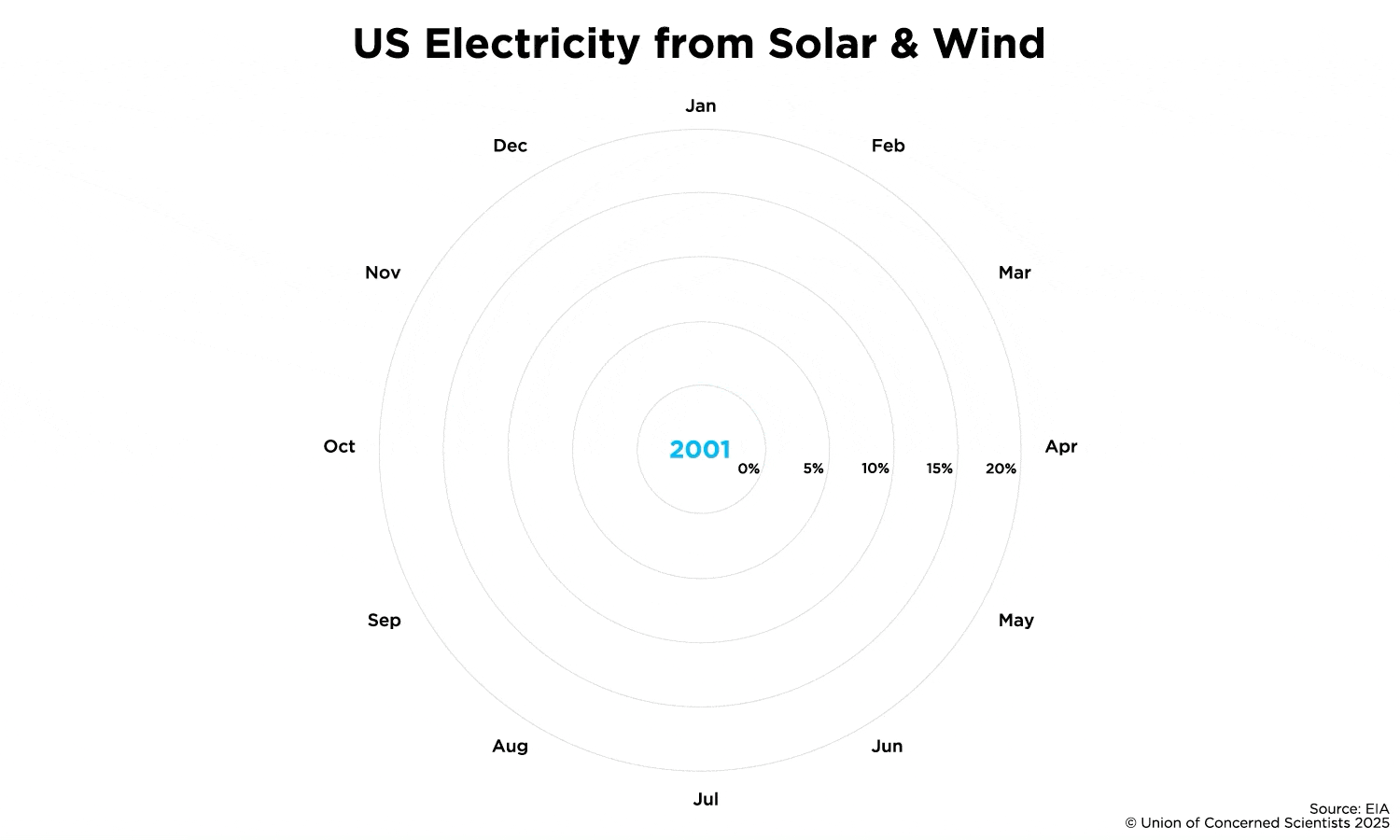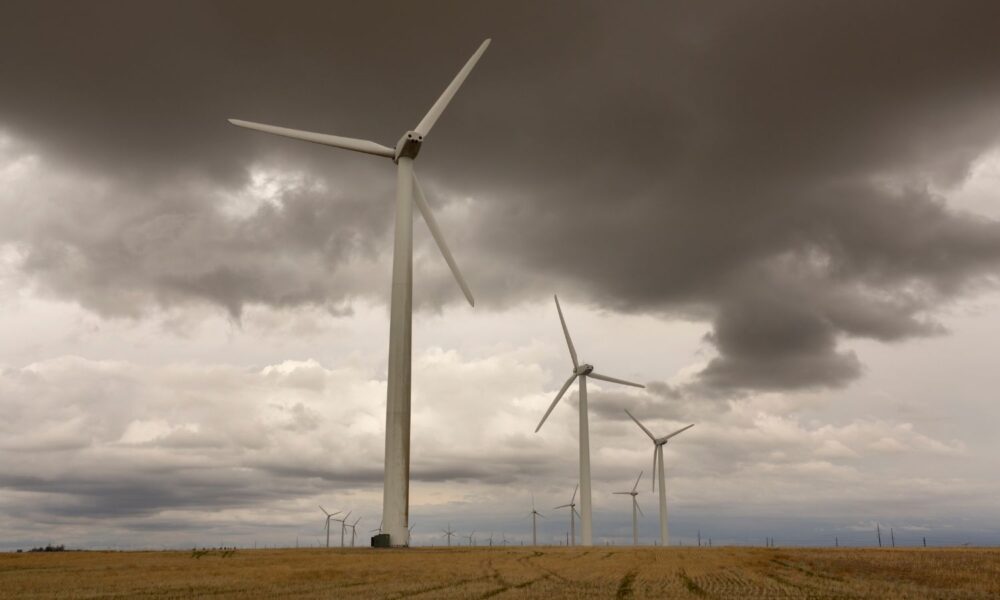Renewable energy in the United States has grown by leaps and bounds in recent years. But the actions of President Trump and [the Republican-controlled] Congress threaten to take a sledgehammer to that progress. Here’s the clean energy momentum at stake, the threats to that momentum, and why there is still reason for hope.
Years of clean energy progress, month by month
The graph of progress on clean energy from the Union of Concerned Scientists (UCS) shown below says a lot about where we’ve come from, over the long term and in recent times.
Based on data from the US Energy Information Administration (EIA) and UCS calculations, the graph shows the portion of total US electricity generation that came from solar and wind each month for the last two and half decades.

Here’s some of what I see in that virtuous spiral of clean energy progress:
- The early days represented in the data had very little generation from wind, and very very little from solar; combined, wind and solar generation reached 1% on a monthly basis for the first time only in 2007.
- But then things heated up: wind and solar generated more than 5% of monthly electricity for the first time in 2013, passed the 10% point in 2017, leapt past 15% in 2021, and soared past 20% just one year later, in 2022.
- Wind and solar have supplied at least 10% of US electricity in every single month since September 2021.
- In April 2024 solar and wind hit a record 23%—meaning that almost one in every four kilowatt-hours of electricity used in this country flowed from wind turbines and solar panels. The combined generation that month was 15% higher than the previous April’s.
A large part of what drove those latest leaps was the tremendous recent progress with solar big and small. US solar had a record-breaking year in 2023—and quickly went on to even greater heights; it had its strongest year ever in 2024.
According to data from analytics firm Wood Mackenzie and the Solar Energy Industries Association (SEIA), the total solar capacity installed during 2024 was 24% above the previous record, and well more than double any other year’s tally. On average US installers put in more than one new solar project every single minute of the year; by the end of the year the country had more than 5.4 million solar photovoltaic systems installed in total, the vast majority of which were small-scale ones on rooftops and over parking lots.
Overall, US renewable energy generation, principally from wind, solar, and hydro, was 10% higher in 2024 than in 2022, and accounted for more than 24% of our nation’s electricity, vs. 13.4% in 2014.
So much momentum.
Changing winds
So… about that momentum. An appreciation of all the recent progress with clean energy has to be viewed in the context of 2025’s reality. This year is not last year, and the environment for clean energy progress has changed drastically. In so many ways.
Here are just a few:
- Administrative actions – Many of the actions of President Trump and his administration have underscored his decidedly unhealthy obsession with promoting fossil fuels and degrading renewables. Those include issuing executive orders that seek to hit wind power hard both offshore and on land and to prop up coal power plants, which are increasingly uneconomic (and have always been bad for public health). They include the president proposing, in his 2026 budget, to slash billions of dollars in funding for energy efficiency and renewable energy. And they include wide-ranging regulatory rollbacks—not least, the remarkable step of proposing to repeal the existing safeguards against carbon and toxic pollution from gas- and coal-fired power plants, which would be another heavy thumb on the scales in favor of fossil fuels over renewables, and of pollution over people.
- Tariffs – The president’s chaotic and punitive trade policies, a blow to many dimensions of the US economic wellbeing, may hit renewable energy especially hard. Included in the insults are his dramatically ramped-up taxes on imported aluminum and steel. Solar will also be hit by a recent decision by the Department of Commerce to levy tariffs of 14.64% to 3,500% (no, that’s not a typo) on imports from the Southeast Asian countries that have been principal solar suppliers to the United States. While investments in US solar manufacturing soared after the passage of the Inflation Reduction Act, imported solar cells are still important inputs for a lot of that manufacturing.
- Reconciliation – And then there’s the budget reconciliation bill that the House of Representatives just passed, which would cause massive additional disruptions to our ongoing clean energy progress by undoing key clean energy incentives. A failure by the Senate to fix or reject the House version’s attacks on clean energy provisions would lead to staggering drops in clean energy investment and jobs, and unacceptable increases in energy bills and pollution.
And yet…
These are dark days in terms of the federal policy environment for the United States’ move to a cleaner, fairer electricity system. Even so, there are bright spots to keep in mind.
One is the data so far in 2025 about US renewables:
- According to EIA data, renewable electricity generation in the first quarter of this year was 10% higher than in Q1 of 2024.
- March 2025 is the new reigning champion for wind and solar generation, with just shy of 24% of electricity supply coming from just those two sources; we’re likely to see a new monthly champion once the April data become available.
- March was also the first month in history in which non-fossil resources (renewable energy and nuclear power) supplied more than half of US electricity.
- While new solar installations were appreciably lower than in Q4 of 2024, January-March was still the fourth highest quarter ever. Texas alone installed 2,700 megawatts (MW) of solar that quarter, or enough to serve several hundred thousand households. Also according to Wood Mackenzie/SEIA, technical advancements and other savings offset the initial cost increases for imported solar panels.
- Solar, wind, and storage accounted for 99% of the electrical capacity installed in Q1—an even higher portion than the 94% tally from 2024.
- This year has also seen another leap in domestic supply, with another 20% increase in US solar panel manufacturing capacity in Q1 alone. That leap brought the total manufacturing capacity in the country to 51,000 megawatts per year.
Another reason for hope is the powerful signs of new growth and innovation, often driven by states. Even as another large-scale offshore wind project has just been suspended, construction continues at five other large-scale offshore wind projects in the Northeast and Mid-Atlantic. The first such project, due to be finished by soon off New England’s coasts, will by itself add 800 megawatts (enough to serve some 400,000 households) and more than quadruple the amount of offshore wind currently serving this country, and provide a powerful new resource for winter reliability in the region. And the largest project under construction, off Virginia, will add another 2,600 megawatts when it is completed next year.
Also encouraging is the continued commitment of much of the rest of world to pushing renewables forward, with projected investment in solar, wind, and other renewables totaling hundreds of billions of dollars in 2025 alone—several magnitudes greater than the expected investments in coal and gas.
The most powerful reason for optimism around US renewable energy, though, is the clear advantages that renewables can offer. Massive natural resources in the wind, the sun, the earth, and water. Electricity generation without carbon emissions, or toxic pollution. Resilient energy that isn’t laid low by fuel-line disruptions or a lack of cooling water. Job creation and local economic development. In the case of solar and wind in many parts of the country, often the lowest-cost new electricity, at a time when energy affordability is a key concern for many homes and businesses.
Onward
Despite the abdication of leadership on clean energy in Washington, or downright hostility, renewables’ considerable momentum will carry it through to new records in 2025; we have only begun to taste the fruits of all the solar and wind installed over the last year. And its many advantages mean that much more renewable energy will be coming, even with the assaults, and even if it takes a little longer.
The facts are on our side, even when the politics and the federal level aren’t, and the fundamentals of clean energy are stronger than ever. Clean energy is here to stay.

